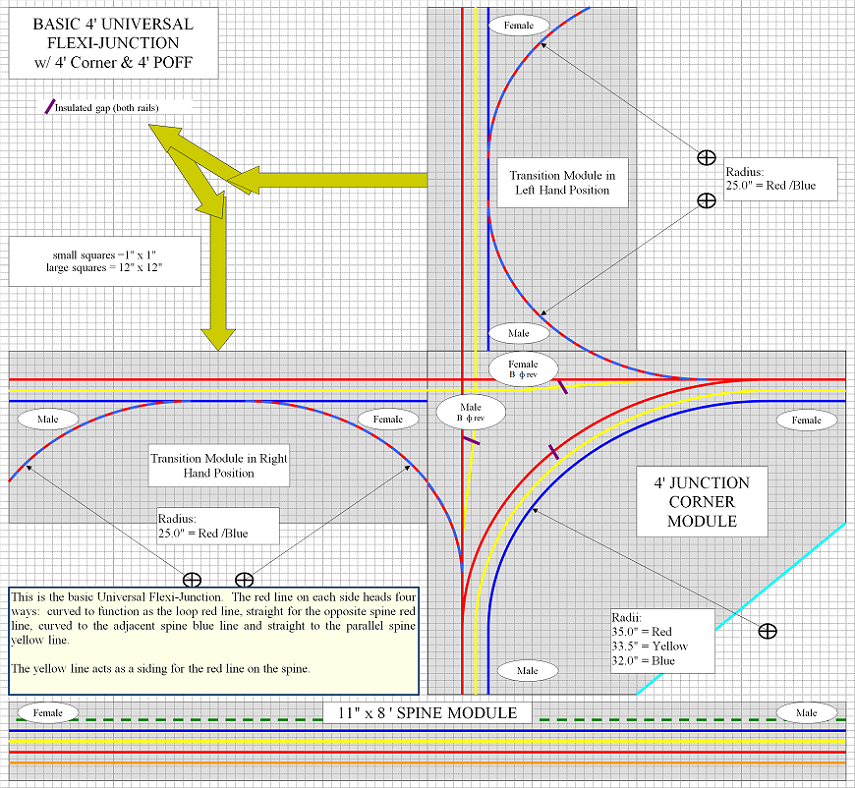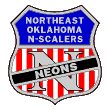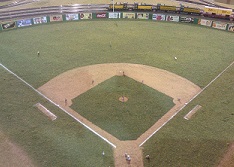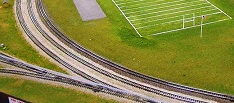NEONS N-TRAK Universal Flexi-Junction
by Steve Gillett
With the expanding use of DCC and the increasing popularity of the Red Line Route™ (RLR), more and more clubs
and individuals are constructing junction modules. As a policy, N-Trak standards for junction modules are minimal,
leaving the modeler with as much flexibility as possible.
Early in the evolution of junction modules the standard thinking was that they would be used in pairs, and that
if the pair worked together, all was good. The problem was that one module would be in the club’s loop, but the
mate would have to be in the next loop. Further, there would be a “foreign” junction module in the club’s loop
to handle the link on the other side. Many clubs didn’t like that arrangement, wanting to showcase their modules
in their own loop. Consequently, junction modules are still often built in pairs, but the two are not usually
paired together since the clubs prefer to place both of their junctions in their own loop.
Since junction modules are usually larger than normal corner modules, and since they usually are built in pairs,
then logic would dictate that those modules should be as flexible and universal as possible so that they would be
able to satisfy whatever the layout planner requires. A normal pair means one left hand junction and one right
hand junction (the left / right indicating which side connects to the spine as you are looking at the module from
the front.) Unfortunately, sometimes the overall layout design calls for a loop to have two left hand junctions
and no right hand junctions or vise-versa, and other times it calls for only one junction module.
By building a pair of “Universal Flexi-Junction” modules similar to the ones described in this article, you will
be able to satisfy any layout requirement. It is done by building each junction as a two-module set, a 4’ corner
module and a POFF (plain ol’ four-footer) transition module. The corner module is identical to a regular corner
module except for the turnouts off the red line, and it can be used as a normal corner module when not required as
a junction. The ones shown here are “Universal” because they can function as either a left hand or right hand
junction depending on the placement of the transition module. Each junction functions correctly whether the
transition module is on the left or on the right side. (See
Drawing 1)
In order to have a "Universal" junction, a 4' corner must be used. A 3' corner doesn't have enough space for all of
the track necessary for a Universal design.

Drawing 1 - Basic 4' Flex-Junction
The POFF or transition module is a normal 4’ module that can be used anywhere in the layout if it’s not
being used as part of a junction corner. There are two things that make a transition module special:
- It has two turnouts off the blue line that link up to the junction module and makes the RLR return
line. By having this curve on both sides, the transition module can be attached to the left or the
right side of the junction module to make the pair a left hand or right hand junction.
- It has a hinged skyboard that can be swung out and down so that when used as a transition module on the
spine, it can be lowered to allow the public to view the module from both sides.
Optionally, the POFF could be cut in half to make two 2' transition modules, one for the left side and one for the
right side. Whichever one is not used to complete the junction would be available for use anywhere else in the
layout as a standard 2' module.
One thing many clubs forget is that the curve that connects the blue line on the transition module to the red line on
the corner module is part of the red line and must, therefore, meet red line curve specs, not blue line specs.
In other words it must have a minimum radius of 24 inches, not 18 inches. Of the many junction modules I’ve seen over
the years, over half of them fail to meet that spec. This is particularly true on 3’ junction modules. The design
presented here has a 25” radius turn onto the spine and the curves on the junction are 35”, 33.5” and 32” for the red,
yellow and blue lines respectively. (Note: to build a 3' flexi-junction and meet the 24" minimum radius spec, use a
wye instead of a left or right turnout to split the red line as it diverges to the normal corner turn and to the
junction transition curve.)
The unique thing about junctions is the wiring. On modules which double as regular corner modules, the normal red line
curve MUST BE GAPPED. Remember that the Red Line Route™ leaves the module for the spine and then returns to the other
side. These two sections of red line may not be in the same wiring block of the Red Line Route™ and therefore they
must be isolated from each other. In essence, there will be two separate sets of red line wiring. Junction modules
that are used as regular corners and not as junctions will require an electrical switch that, when thrown, ties the
two red line wiring sets together for normal loop operations. Also, the two bus-line plugs on the corner module
that connect to the blue line on the transition module must have the polarity reversed in the plug, i.e.
red/outside/ribbed wire to Cinch Jones narrow pin or to Power-pole black case.
There is a “recommended practices” dissertation in the N-Trak manual that describes all of the wiring “how to’s” in
detail. I suggest one change to that recommendation. The normal red line curve (the one parallel to the yellow line)
on the corner module should only have one set of insulated gaps cut it. That way, by simply flipping the two turnouts
off the main line from closed to thrown, the module automatically functions as a normal corner with the insulated gap
acting as a block boundary. This way, when someone brings a train onto the RLR, he/she can take a couple of shake
down laps around the host loop to find any bad order cars or other problems before venturing out to other loops along
the RLR (hence the term “Flexi-Junction.)
The biggest potential problem with miss-mated junctions concerns the use of the yellow line on the spine. Some
junctions use the yellow line as a siding off the blue (aka red reverse), some use it as a siding for the red, and a
few tie the yellow to both the red and blue. This conflict will cause an electrical problem on the spine yellow line
if the paired junctions are not both set the same way since the blue line has reversed polarity while the red line has
normal polarity. The universal flexi-junction corner module has an insulated gap in the yellow sidings just after the
turnout. A slide switch controls whether or not red line power is fed down the yellow line.
While
Drawing 1
shows the Basic 4' Universal Flexi-Junction,
Drawing 2
shows the Enhanced version and
Drawing 3
shows the Deluxe version. These improvements include the use of the orange line and giving the yellow spine line
the option of connecting to both the red and the blue (red reverse) lines.
Additionally, Drawings
4,
5 and
6
show the
Basic,
Enhanced and
Deluxe
designs for a 3' Flexi-Junction.
The
NEONS Universal Flexi-Junction modules can be seen by clicking on these links. We make a concerted effort
to model realistic scenes that depict life in Oklahoma, which is a mostly rural state famous for the Dust Bowl of
the 1930’s and for our reddish colored soil. All four of these modules meet that goal.
Junction Corner Baseball:
Every town has a ball park and our Oklahoma community is no different. Fitting nicely inside the junction between two railroads, the ballpark fence has advertising billboards covering its face and protects outfielders from straying too near the tracks as they chase long fly balls. Old Glory flies high on the flag pole just above the Oklahoma State flag, wafting in the breeze and indicating to batters that the wind is in their favor today. The town council has promised a new scoreboard for next season. (NOTE: this diamond is to scale with 90’ base paths and the outfield fence is 300 scale feet from home plate.)
Transition Module Beucher Farm:
The “Dust Bowl” days are now history and life has returned to normal in central Oklahoma. This farm scene shows new crops sprouting from the red, Oklahoma soil. The crops are being pollinated by several bee hives brought in especially for that purpose.
Junction Corner Football:
High School football is big in Oklahoma and our town’s football field is being groomed and made ready for the 1957 season. Oklahoma is mostly rural, with small towns that are too far apart for consolidated school districts. These smaller schools play 8-man football as opposed to the 11-man version played at larger high schools. Prior to 1958, goal posts were the ‘H’ style and sat at the back of the end zone. Back then, running a post pattern could get your bell rung! Old Glory flies high on the flag pole, its 48 stars and 13 stripes fluttering in the breeze just above the Oklahoma State flag. (NOTE: the football field is also to scale.)
Transition Module Skeet Shoot:
Few things are more sacred to Okies than their right to bear arms. A favorite sport down our way is skeet & trap shooting. Nestled in between two railroad spurs is the local shooting range. It has six shooting bays, launch towers and all the accessories. Load up, aim and holler “PULL!”





